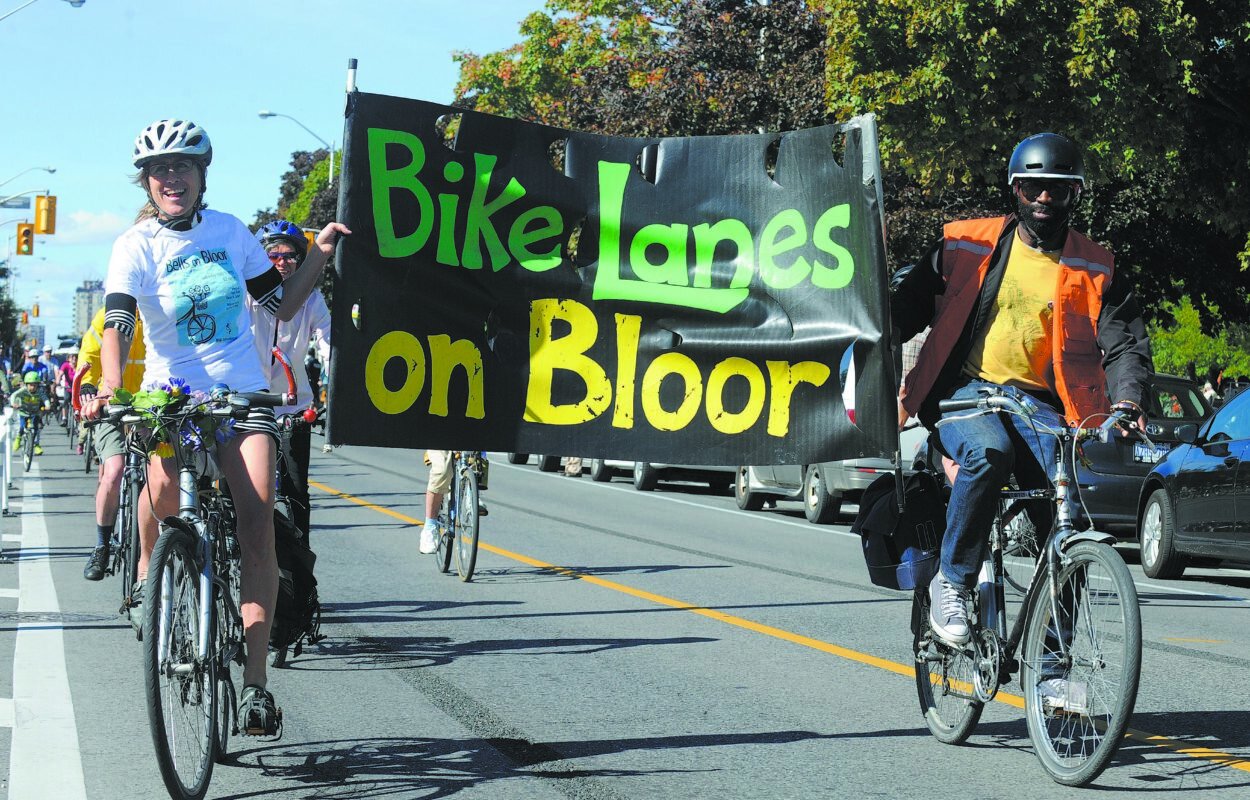
A Short History of Bike Lanes on Bloor
The fight for bike lanes on Bloor has been the longest and most important cycling advocacy battle in the city's history.
Bloor is a direct, flat, East-West transportation route tying several parts of the Toronto together, especially if one includes contiguous Danforth Avenue. Additionally, the Bloor-Danforth subway provides a valuable option for other travellers along the route, and allows people to make trips by a combination of bike and subway.
Over the past two decades, "Bike Lanes on Bloor" became a virtual rallying cry for safe cycling, not only calling attention to the need for an East-West cycling spine, but reflecting the long neglect by City Hall of cycling infrastructure. One could actually go all the way back to the Bicycle Craze of the 1890s to find demands by advocates for a bikeway along Bloor Street (then the northern boundary of the city). Although in those days, the bicycle got a lot more respect than it does even today.
But to keep this story brief, we’ll limit this summary to the modern era, beginning with the Bicycle Boom that reached Toronto in the early 1970s.
A 1978 cycling report for the city by consultant Barton-Aschman considered Bloor for a bike lane, then settled for a wider curb lane on parallel Harbord St. In the early 1990s, another city consultant, Marshall Macklin & Monaghan, recommended Bloor-Danforth for a cross-town cycling spine. Nothing came of the recommendation, although a truncated bike lane across the Bloor Viaduct to Sherbourne Street was installed in 1991. The 2001 Bike Plan, Shifting Gears, didn't even include Bloor-Danforth, but that plan turned out to be a failure for a long list of other reasons.
In 2005, a group called Take the Tooker asked city residents to "Imagine a bike lane on Bloor-Danforth." The group, established by Hamish Wilson and Angela Bischoff (in honour of her late spouse, activist Tooker Gomberg), rolled out to significant media attention a tar paper bike lane on a stretch of Bloor in Yorkville. The group also held bike rides on Bloor with dozens of participants. At the time, the thinking (even among many bike lane supporters) was that a bike lane on Bloor was a nice idea, but “not realistic.”
Bells on Bloor, formed in 2007 (and now a member group of the Toronto Community Bikeways Coalition) brought together several groups and advocates including Wilson and Bischoff, as well as Don Watterson (Curbside Bikes), Albert Koehl, Kristen Courtney (Bikes on Bloor), Elizabeth Marchand, and Jode Roberts. Their original objective was to hold mass “pedal-powered” annual bike parades along Bloor to demonstrate popular support for a bike lane. The first Bells on Bloor parade took place in September 2007 with 500 riders. In 2009, the parade drew an estimated 2,000 cyclists, the biggest-ever cycling advocacy ride in the city's history. (The Ride for Heart is a fundraising ride.) In 2014, the parade ended at City Hall with BIKESTOCK, a musical rally which brought together Bells on Danforth, Bells on Yonge and a number of other groups.
A 2009 report by The Toronto Coalition for Active Transportation (TCAT) was another milestone in the long fight for bike lanes on Bloor. TCAT's research (followed by similar studies with similar results) showed that among patrons at local stores only 10% arrived by car. This refuted long-held assumptions that merchants' survival depended on curbside car parking. In fact, people on foot, bikes, and transit were far more important to local business, and spent more money during visits to shops.
In 2008, a group calling itself The Safe Cycling Coalition took the city to court for its failure to consider the installation of bike lanes in its revitalization project of Bloor Street in upscale Yorkville. The challenge failed, although Ontario’s environment commissioner criticized the city’s approach. A year later, bicycle courier Darcy Allan Sheppard was killed in the very segment of Bloor that was subject of the court challenge.
Bells on Bloor continued its rides over most of the next decade while expanding its work into a broad range of advocacy activities. In October 2013, when it was apparent that a cross-town Bloor lane was far beyond the imagination of City Hall, Bells on Bloor proposed a pilot bike lane along a segment of Bloor to demonstrate that a bike lane would succeed. Instead of acting on the proposal, City Council instead approved an expensive, unnecessary environmental assessment for the project, with no commitment to action.
A number of groups nonetheless rallied around the initiative for a pilot. Most notably, all six local residents’ associations between Avenue Road and Shaw Street, under the leadership of David Harrison of the Annex Residents' Association (ARA). The ARA had already adopted, in 2011, a cycling policy, that included bike lanes on Bloor.
In a January 2014 letter (drafted by Bells on Bloor), the residents' associations called for a pilot bike lane. This pilot got another boost in late 2014 when Joe Cressy was elected as the local councillor and, along with councillor Mike Layton, made installation of the pilot bike lane a priority.
In 2015, the community coalition for a pilot bike lane continued to grow to include groups such as Cycle Toronto, Doctors for Safe Cycling, students, and the Metcalf Foundation, among others. Support for the bike lane pilot also began to include the media, including the Toronto Star, which in an earlier era had vehemently opposed bike lanes on arterial roads.
The pilot bike lane was installed in August 2016. The Bloor Annex BIA, which supported the pilot, helped fund a study of the economic impacts of the bike lane. Meanwhile The Tour de Bloor passport, an initiative by Bells on Bloor, Cycle Toronto and local residents’ associations, was launched to promote shopping among cyclists at local shops. The apparent popularity of the bike lane did not assure the permanent implementation of the bike lane, until the economic study, to which TCAT contributed, showed that business was actually up. The pilot was made permanent by a council vote in November 2017, but even though the city's transportation manager described the pilot bike lane as the most-studied road project in recent North American history, it would take more advocacy to extend the bike lane westward.
Bells on Bloor recruited turtles to the cause to demonstrate the slow pace of action, and partnered with other advocates and groups, including the David Suzuki Foundation, Cycle Toronto, Doctors for Safe Cycling, neighbourhood groups, the Metcalf Foundation, businesses and many others on initiatives that included bike counts, a public meeting, postcard campaign, community sign-on letter, videos, deputations at City Hall, and meetings with city councillors. The canvassing of Bloor businesses and related enterprises obtained 100 signatures for the community letter calling for the extension of the bike lane.
In the summer of 2019, Bloor councillors called for the permanent installation of an extended Bloor bike lane by "as early as" the summer of 2020. The global pandemic intervened, spurring and securing the installation of the Bloor extension westward to Runnymede, as well as the closing in the summer of 2020 of a gap along Bloor Street East (which the city hadn't been willing to contemplate until 2022).
Now the work continues, with advocates drawing on the same tools that have served them well in the battle to date, although supported by a far greater swath of society in a changing city where a pre-pandemic EKOS poll found that a majority of city residents identified walking, cycling, and transit as their primary mode of travel. Indeed, figures from the Ontario Ministry of Transportation showed that 55% of Toronto residents walk, cycle or take transit for their commute to work and school.

